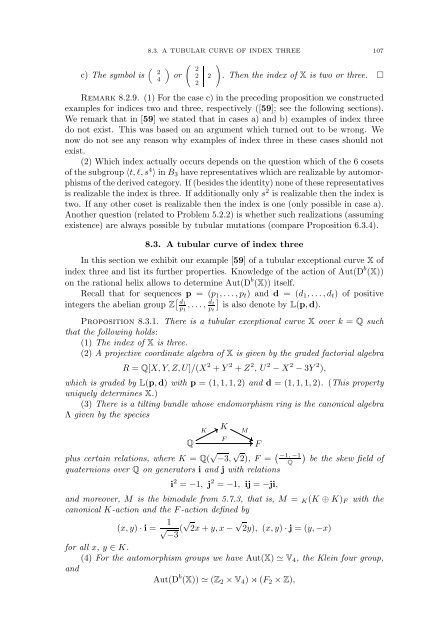MEMOIRS
MEMOIRS
MEMOIRS
- No tags were found...
Create successful ePaper yourself
Turn your PDF publications into a flip-book with our unique Google optimized e-Paper software.
c) The symbol is „ 248.3. A TUBULAR CURVE OF INDEX THREE 1070«or @ 2 2 221A. Then the index of X is two or three. □Remark 8.2.9. (1) For the case c) in the preceding proposition we constructedexamples for indices two and three, respectively ([59]; see the following sections).We remark that in [59] we stated that in cases a) and b) examples of index threedo not exist. This was based on an argument which turned out to be wrong. Wenow do not see any reason why examples of index three in these cases should notexist.(2) Which index actually occurs depends on the question which of the 6 cosetsof the subgroup 〈t, l, s 4 〉 in B 3 have representatives which are realizable by automorphismsof the derived category. If (besides the identity) none of these representativesis realizable the index is three. If additionally only s 2 is realizable then the index istwo. If any other coset is realizable then the index is one (only possible in case a).Another question (related to Problem 5.2.2) is whether such realizations (assumingexistence) are always possible by tubular mutations (compare Proposition 6.3.4).8.3. A tubular curve of index threeIn this section we exhibit our example [59] of a tubular exceptional curve X ofindex three and list its further properties. Knowledge of the action of Aut(D b (X))on the rational helix allows to determine Aut(D b (X)) itself.Recall that for sequences p = (p 1 ,...,p t )andd = (d 1 ,...,d t ) of positiveintegers the abelian group Z [ ]d 1p 1,..., d tp tis also denote by L(p, d).Proposition 8.3.1. There is a tubular exceptional curve X over k = Q suchthat the following holds:(1) The index of X is three.(2) A projective coordinate algebra of X is given by the graded factorial algebraR = Q[X, Y, Z, U]/(X 2 + Y 2 + Z 2 ,U 2 − X 2 − 3Y 2 ),which is graded by L(p, d) with p =(1, 1, 1, 2) and d =(1, 1, 1, 2). (This propertyuniquely determines X.)(3) There is a tilting bundle whose endomorphism ring is the canonical algebraΛ given by the speciesKKFQFplus certain relations, where K = Q( √ −3, √ 2), F = ( )−1, −1Q be the skew field ofquaternions over Q on generators i and j with relationsi 2 = −1, j 2 = −1, ij = −ji,and moreover, M is the bimodule from 5.7.3, that is, M = K (K ⊕ K) F with thecanonical K-action and the F -action defined by(x, y) · i = √ 1 ( √ 2x + y, x − √ 2y), (x, y) · j =(y, −x)−3for all x, y ∈ K.(4) For the automorphism groups we have Aut(X) ≃ V 4 , the Klein four group,andAut(D b (X)) ≃ (Z 2 × V 4 ) ⋊ (F 2 × Z),M
















